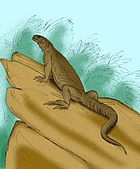Catactegenys
Appearance
| Catactegenys Temporal range: Late Cretaceous (late Campanian)
| |
|---|---|
| Scientific classification | |
| Domain: | Eukaryota |
| Kingdom: | Animalia |
| Phylum: | Chordata |
| Class: | Reptilia |
| Order: | Squamata |
| Family: | Xantusiidae |
| Genus: | †Catactegenys Nydam et al., 2013 |
| Type species | |
| †Catactegenys solaster Nydam et al., 2013
| |
Catactegenys is an extinct genus of xantusiid lizard from the Late Cretaceous of Texas. The type species, Catactegenys solaster, was named in 2013 from the late-Campanian-age Aguja Formation in Brewster County. The genus name means "breaker jaw" in Greek, a reference to its inferred ability to break hard shells with its jaws as an adaptation for a durophagous diet, and the species name means "lone star", a reference to Texas, the "lone star state". Catactegenys is known only from jaw bones, but the size of these bones indicates that it was larger than all other known xantusiids. The teeth are robust and heavily worn, suggesting that Catactegenys may have eaten hard-shelled molluscs, which are common in the Aguja Formation.[1]
References
[edit]- ^ Nydam, Randall L.; Rowe, Timothy B.; Cifelli, Richard L. (2013). "Lizards and snakes of the Terlingua Local Fauna (late Campanian), Aguja Formation, Texas, with comments on the distribution of paracontemporaneous squamates throughout the Western Interior of North America". Journal of Vertebrate Paleontology. 33 (5): 1081. Bibcode:2013JVPal..33.1081N. doi:10.1080/02724634.2013.760467.





